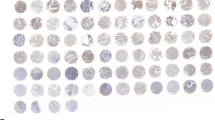Abstract
Autotaxin (ATX), originally isolated from human melanoma cells, is a novel metastasis-enhancing motogen and angiogenesis factor. In the present study, we compared the expression level of ATX mRNA between normal and breast cancer tissues and found that the expression of ATX mRNA was closely linked to invasiveness of cancer cells. Reverse transcriptase-polymerase chain reaction (RT-PCR) and immunohistochemical analysis showed higher cellular ATX mRNA expression in the cancer than normal breast tissues. MDA-MB-435S breast cancer cells, expressing higher amount of ATX mRNA, showed greater relative invasiveness to fibroblast-conditioned medium (FCM) than MCF7, MDA-MB-231, and HBL-100 breast cancer cells. Furthermore, ATX-transfected MCF7 cells showed increased motility and invasiveness than vector-transfected MCF7 cells. Collectively, our results suggest that the expression of ATX is closely linked to the invasiveness of breast cancer cells.
Similar content being viewed by others
References
Singer SJ, Kupfer A. The directed migration of eukaryotic cells. Annu Rev Cell Biol 1986; 2: 337–65.
Hankinson SE, Willet WC, Colditz GA et al. Circulating concentrations of insulin-like growth factor and risk of breast cancer. Lancet 1998; 35: 1393–6.
Meng Q, Mason JM, Porti D et al. Hepatocyte growth factor decreases sensitivity to chemotherapeutic agents and stimulates cell adhesion, invasion, and migration. Biochem Biophys Res Commun 2000; 274: 772–9.
Stracke ML, Krutzsch HC, Unsworth EJ et al. Identification, purification, and partial sequence analysis of autotaxin, a novel motility-stimulating protein. J Biol Chem 1992; 267: 2524–9.
Buckley MF, Loveland KA, McKinstry WJ et al. Plasma Cell membrane glycoprotein PC-1: cDNA cloning of the human molecule, amino acid sequence, and chromosomal location. J Biol Chem 1990; 265: 17506–11.
Kawagoc H, Soma O, Goji J et al. Molecular cloning and chromosomal assignment of the human brain-type phosphodiesterase I/nuclotide pyrophosphatase gene (PDNP2). Genomics 1995; 30: 380–4.
Deissler H, Lottspeich F, Rajewsky MF. Affinity purification and cDNA cloning of rat neural differentiation and tumor cell surface antigen gpl30RB13-6 reveals relationship to human and murine PC-1. J Biol Chem 1995; 270: 9849–55.
Lee HY, Murata J, Clair T et al. Cloning, chromosome localization, and tissue expression of autotaxin from human teratocarcinoma cells. Biochem Biophys Res Commmun 1996; 218: 714–9.
Kawagoc H, Stracke ML, Nakamura H et al. Expression and transcriptional regulation of the PD-Ia/autotaxin gene in neuroblastoma Cancer Res 1997; 57: 2516–21.
Yang Y, Mou L, Liu N et al. Autotaxin expression in non-small cell lung cancer. Am J Respir Cell Mol Biol 1999; 21: 216–22.
MacDonald NJ, Freije JMP, Stracke ML et al. Site-directed mutagenesis of nm23-H1. Mutation of proline 96 or serine 120 abrogates its motility inhibitory activity upon transfection into human breast carcinoma cells. J Biol Chem 1996; 271: 25107–16.
Lee HY, Clair T, Mulvaney PT et al. Stimulation of tumor cell motility linked to phosphodiesterase catalytic site of autotaxin. J Biol Chem 1996; 271: 24408–12.
Rong S, Segal S, Anver M et al. Invasiveness and metastasis of NIH 3T3 cells induced by Met-hepatocyte growth factor/sactter factor autocrine stimulation. Proc Natl Acad Sci USA 1994; 91: 4731–5.
Nam SW, Clair T, Campo CK et al. Autotaxin (ATX), a potent tumor motogen, augments invasive and metastatic potential of rastransformed cells. Oncogene 2000; 19: 241–7.
Nam SW, Clair T, Kim YS et al. Autotaxin (NPP-2), a metastasis-enhancing motogen, is an angiogenic factor. Cancer Res 2001; 61: 6938–44.
Zhao Z, Xu S, Zhang G. A study on expression of autotaxin mRNA in hepatocellular crcinoma. Zhonghua Gan Zang Bing Za Zhi 1999; 7: 140–1 [in Chinese].
Brown PD, Levy AT, Margulies IM et al. Independent expression and cellular processing of the 72-kDa type IV collagenase and interstitial collagenase in human tumorigenic cell lines. Cancer Res 1990; 50: 6184–91.
Margulies IM, Hoyhtya M, Evans C et al. Urinary type IV collagenase: Elevated levels are associated with bladder transitional cell carcinoma. Cancer Epidemiol Biomarkers Prev 1992; 1: 462–74.
Murata J, Lee HY, Clair T et al. cDNA cloning of the human tumor motility-stimulating protein, autotaxin, reveals a homology with phosphodiesterases. J Biol Chem 1994; 269: 30479–84.
Silva D, English D, Lyons D et al. Protein kinase C induces motility of breast cancers by upregulating secretion of urokinase-type plasminogen activator through activation of AP-1 and NF-kappaB. Biochem Biophys Res Commun 2002; 290: 552–7.
Author information
Authors and Affiliations
Rights and permissions
About this article
Cite this article
Yang, S.Y., Lee, J., Park, C.G. et al. Expression of autotaxin (NPP-2) is closely linked to invasiveness of breast cancer cells. Clin Exp Metastasis 19, 603–608 (2002). https://doi.org/10.1023/A:1020950420196
Issue Date:
DOI: https://doi.org/10.1023/A:1020950420196




